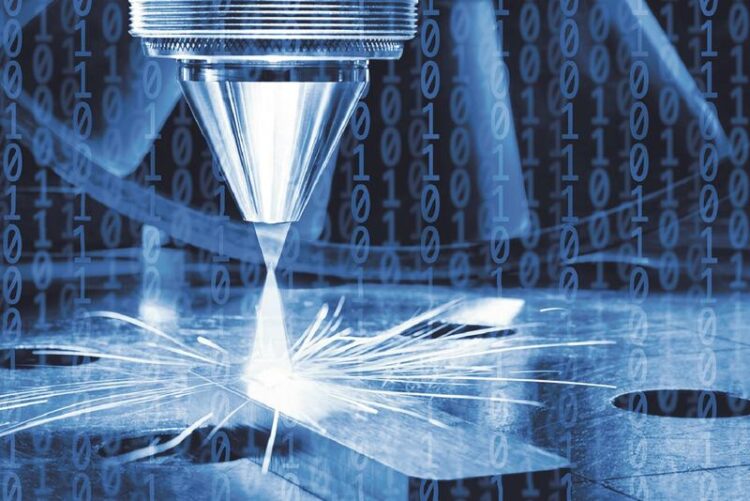What can AI do in laser materials processing?

At the third "AI for Laser Technology Conference" in Aachen on November 23 and 24, 2023, experts will discuss trends and visions of what AI can achieve in laser materials processing in the future.
© Fraunhofer ILT, Aachen, Germany
Automation and zero-defect production are important trends in machine construction. Artificial intelligence (AI) plays a major role in advancing both of them. Today, it can already detect deviations in process monitoring data and implement quality control in real time. In the future, AI will regulate many more processes and simplify process planning through assistance functions.
At the third “AI for Laser Technology Conference” on November 23 and 24, 2023, these and other trends in the application of AI in materials processing will be discussed.
A modern system for laser material processing supplies considerable amounts of data: On the one hand, the optical elements in the laser and in the processing head can be monitored, and on the other, process monitoring provides data from the interaction zone. Today, this data already makes it possible to monitor and document the quality of the individual processing steps, which helps users, for example, evaluate changes in the machining process over time or over many machines.
The same applies to the status of a machine or an entire series of laser systems – here, too, changes can be tracked over time or across a number of machines. This generates considerable amounts of data, which are processed locally or centrally. Furthermore, images consist of huge amounts of data, and artificial intelligence has already become established in evaluating them. The systems are trained to detect and clearly classify deviations from the norm or even errors or malfunctions.
Design laser systems for AI application
“These AI capabilities are well known, now it’s a matter of building new machines that are designed from the outset to make the most of AI’s potential,” is how Professor Carlo Holly, one of the organizers of this year’s AI for Laser Technology Conference, describes an important trend. “The sensor technology and the algorithms must fit together and ideally be planned in a coordinated manner from the outset,” he adds.
The next goal is self-learning machines. They are to work in four steps: First, the sensors generate the data from the process. Then, the data is analyzed and made understandable, i.e. interpreted on the basis of existing data. In a third step, the system simulates how the results of the process will develop. For this purpose, the previous trend can be extrapolated or the influence of certain parameters can be simulated. This enables the fourth step: system control. So far, AI has been used mainly for quality monitoring and predictive maintenance of the machine. A closed control loop is the “next big thing.”
Simplify process planning with AI
But as digital process data becomes increasing available, AI can do even more. The data from the past makes it possible to calculate a parameter range for a new machining task and a specific material in which the process should run well. When a new machining process is planned and set up, AI can save time and resources, and therefore money.
“AI can find an optimal solution within multi-parameter systems, for which a human would need much more time,” Holly explains. With AI, new processes can be tested in the computer, as is known from digital twins in the field of Industry 4.0. The complexity here has another dimension: “With these high-tech systems, we are increasingly facing the challenge of finding junior staff with suitable multiple qualifications,” says Holly. After all, anyone who wants to simulate and plan a system like this should have knowledge of mechanical engineering, computer science and physics. The presentations at the AI Conference highlight the need for an interdisciplinary approach and contribute to training the participants.
The fields of application are broad
“We’re already seeing AI in use, but that’s just the beginning” is how Holly describes the status quo. AI is used in the detection of defects in welds or in the sorting of metallic waste. At the third “AI for Laser Technology Conference” on November 23 and 24, 2023 in Aachen, several presentations will deal with applications, joining and additive manufacturing, among others. Naturally, software and infrastructure is also a major topic, which is why Microsoft’s plenary talk is eagerly awaited. “In the end, it’s all about integrating how systems, processes and algorithms are developed,” Professor Holly sums up the direction of this year’s conference.
For more information on the AI for Laser Technology Conference 2023, please see: https://s.fhg.de/G5Vc
Wissenschaftliche Ansprechpartner:
Prof. Carlo Holly
Head of Department Data Science and Measurement Technology
Telefon +49 241 8906-142
carlo.holly@tos.rwth-aachen.de
Peter Abels
Group Manager Process Control and System Technology
Telefon +49 241 8906-428
peter.abels@ilt.fraunhofer.de
Fraunhofer Institute for Laser Technology ILT
Steinbachstraße 15
52074 Aachen, Germany
www.ilt.fraunhofer.de
Weitere Informationen:
http://www.ilt.fraunhofer.de/en
http://www.ilt.fraunhofer.de/en/fairs-and-events/events/2023/AIL-Conference2023….
Media Contact
All latest news from the category: Event News
Newest articles

Sea slugs inspire highly stretchable biomedical sensor
USC Viterbi School of Engineering researcher Hangbo Zhao presents findings on highly stretchable and customizable microneedles for application in fields including neuroscience, tissue engineering, and wearable bioelectronics. The revolution in…

Twisting and binding matter waves with photons in a cavity
Precisely measuring the energy states of individual atoms has been a historical challenge for physicists due to atomic recoil. When an atom interacts with a photon, the atom “recoils” in…

Nanotubes, nanoparticles, and antibodies detect tiny amounts of fentanyl
New sensor is six orders of magnitude more sensitive than the next best thing. A research team at Pitt led by Alexander Star, a chemistry professor in the Kenneth P. Dietrich…





















